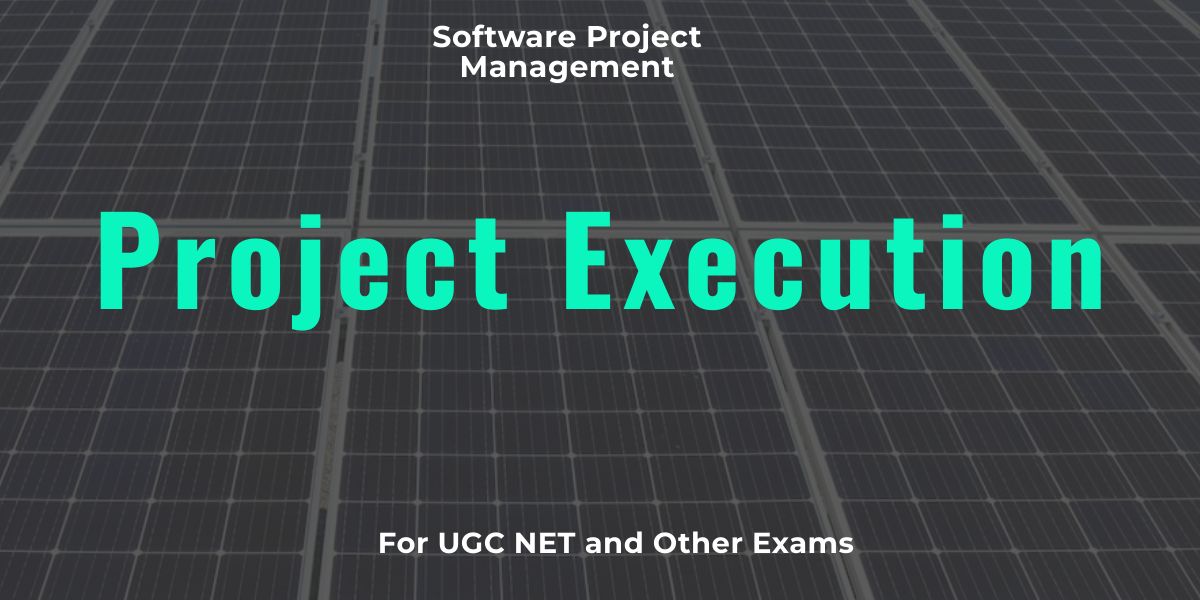
Project Execution
What is Project Execution?
Project Execution is the third phase of the project lifecycle where the project plan is implemented, and deliverables are produced. During this phase, teams complete the actual work, monitor progress, communicate updates, and ensure quality control.
🔹 Key Question: “How do we successfully complete the project?”
🔹 Objective: Deliver the project scope as per the approved plan.
Key Activities in Project Execution
1. Assign and Manage Project Tasks
- Break down work into smaller tasks and assign them to team members.
- Use Work Breakdown Structure (WBS) for clear task distribution.
- Assign roles and responsibilities based on expertise.
📌 Example Task Breakdown (E-Commerce Website):
| Task | Assigned To | Deadline |
|---|---|---|
| UI/UX Design | Designer | Week 2 |
| Backend API Setup | Developer | Week 4 |
| Payment Gateway Integration | Developer | Week 6 |
2. Monitor Progress & Track Performance
- Use Key Performance Indicators (KPIs) to measure progress.
- Track tasks through project management tools like JIRA, Trello, Asana, or MS Project.
- Hold daily stand-up meetings (Scrum) to review tasks and remove blockers.
📌 Common KPIs for Execution Phase:
✔ Task Completion Rate → % of tasks completed on time.
✔ Budget Variance → Difference between actual and planned costs.
✔ Schedule Variance (SV) → Measures if the project is ahead or behind schedule.
✔ Defect Density → Number of defects per 1,000 lines of code.
3. Manage Resources & Workload
- Ensure team members are not overworked to avoid burnout.
- Allocate resources (people, tools, budget) efficiently.
- Adjust workloads based on task complexity and availability.
📌 Example Resource Allocation (Software Development):
| Resource | Assigned Work | Hours/Week |
|---|---|---|
| Developer 1 | Backend API Development | 30 hrs |
| Designer | UI/UX Wireframes | 25 hrs |
4. Communication & Stakeholder Management
- Provide regular project updates to all stakeholders.
- Use weekly progress reports and status meetings.
- Ensure transparent communication about risks and blockers.
📌 Example Communication Plan:
| Stakeholder | Communication Type | Frequency | Method |
|---|---|---|---|
| Project Sponsor | Status Update | Weekly | |
| Team Members | Daily Stand-up | Daily | Video Call |
| Clients | Progress Review | Bi-weekly | Meeting |
5. Risk & Issue Management
- Monitor risks and unexpected issues that arise during execution.
- Maintain a Risk Register to document and track problems.
- Mitigate risks early to avoid project delays.
📌 Example Risk Register:
| Risk | Impact | Likelihood | Mitigation Strategy |
|---|---|---|---|
| Server Downtime | High | Medium | Use cloud backup system |
| Budget Overrun | High | High | Implement cost tracking |
6. Quality Control & Testing
- Conduct regular quality reviews to ensure deliverables meet expectations.
- Perform testing (unit testing, integration testing, user testing, etc.).
- Implement a feedback loop for continuous improvement.
📌 Example Quality Checks (For Software):
✔ Code Review → Ensure best coding practices.
✔ Automated Testing → Catch bugs early.
✔ User Acceptance Testing (UAT) → Get client feedback.
7. Manage Change Requests
- Document and evaluate all change requests before approval.
- Avoid scope creep by controlling unauthorized changes.
- Use a formal change request process.
📌 Example Change Control Process:
1️⃣ Request Submitted → Client requests a new feature.
2️⃣ Impact Analysis → Assess time, cost, and effort.
3️⃣ Approval Process → Project manager & stakeholders approve or reject.
4️⃣ Implementation → Update project scope and timeline.
8. Deliver Project Milestones & Reports
- Track project milestones to ensure timely completion.
- Send weekly progress reports to keep stakeholders informed.
📌 Example Project Milestones (Software Development):
| Milestone | Expected Completion |
|---|---|
| UI Design Finalized | Week 4 |
| Backend Completed | Week 8 |
| Testing Completed | Week 10 |
| Deployment | Week 12 |
Project Execution Tools & Techniques
✔ Project Management Tools → Trello, Jira, MS Project, Asana
✔ Communication Tools → Slack, Zoom, Email
✔ Tracking Tools → Gantt Charts, KPIs, Burn-down Charts
✔ Quality Assurance Tools → Selenium, JIRA, SonarQube
Challenges in Project Execution & Solutions
| Challenge | Solution |
|---|---|
| Scope Creep (Uncontrolled changes) | Use a strict change management process. |
| Missed Deadlines | Track progress with Gantt charts & set buffer time. |
| Poor Communication | Use structured updates (daily stand-ups, reports). |
| Budget Overrun | Regularly compare actual vs planned budget. |
| Resource Overload | Monitor workload & redistribute tasks as needed. |
Project Execution Example (E-Commerce Website)
📌 Objective: Develop an online fashion store.
📌 Timeline: 6 months.
📌 Budget: $100,000.
🔹 Milestones:
✔ Month 1-2: UI/UX Design & Wireframing.
✔ Month 3-4: Backend & Frontend Development.
✔ Month 5: Testing & Quality Control.
✔ Month 6: Deployment & Marketing.
🔹 Tools Used:
- Trello → Task tracking.
- Slack → Team communication.
- JIRA → Bug tracking.
- Google Drive → Document sharing.
Conclusion
Project Execution is where the actual work happens. A successful execution phase depends on clear task management, proper communication, risk control, and quality assurance.
✅ Key Takeaways:
✔ Assign & track tasks effectively.
✔ Monitor performance with KPIs.
✔ Manage risks & changes proactively.
✔ Ensure quality through regular testing.
✔ Communicate effectively with all stakeholders.




